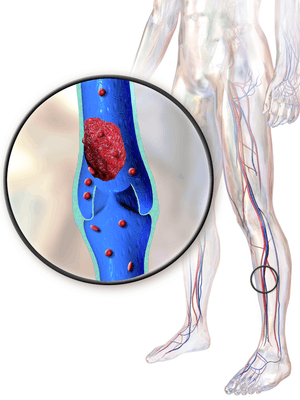Hughes–Stovin syndrome
| Hughes–Stovin syndrome | |
|---|---|
 | |
| Deep vein thrombosis is one of the characteristics of this syndrome | |
| Specialty |
Immunology |
Hughes–Stovin syndrome is a rare autoimmune disorder of unknown cause that is characterized by the combination of multiple pulmonary artery aneurysms and deep vein thrombosis. It is named after the two British physicians, John Patterson Hughes and Peter George Ingle Stovin, who first described it in 1959.[1] It is a rare variant of Behçet's disease, which entails more general problems with the circulatory system. Most patients are young adult males between the age of 20–40. Common clinical presentations include fever, cough, dyspnea and hemoptysis. Radiological features are similar to those of Behçet's disease.[2] There is no satisfactory treatment for this disease.
Symptoms
References
- ↑ Hughes, JP; Stovin, PG (January 1959). "Segmental pulmonary artery aneurysms with peripheral venous thrombosis". British Journal of Diseases of the Chest. 53 (1): 19–27. doi:10.1016/S0007-0971(59)80106-6. PMID 13618502.
- ↑ "Hughes stovin syndrome". Medcyclopaedia. GE.
- 1 2 3 4 5 6 Chalazonitis; et al. (January 29, 2009). "Hughes-Stovin Syndrome: a case report and review of the literature". Cases J. 2: 98. doi:10.1186/1757-1626-2-98. PMC 2649053. PMID 19178695.
External links
| Classification | |
|---|---|
| External resources |
This article is issued from
Wikipedia.
The text is licensed under Creative Commons - Attribution - Sharealike.
Additional terms may apply for the media files.